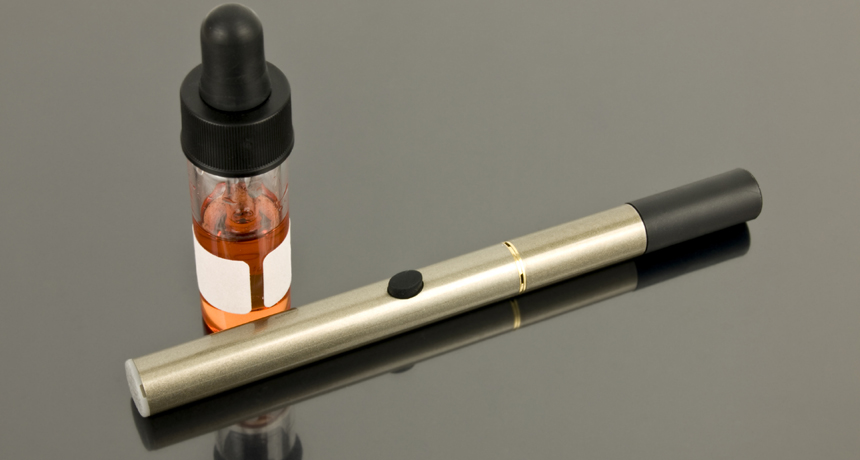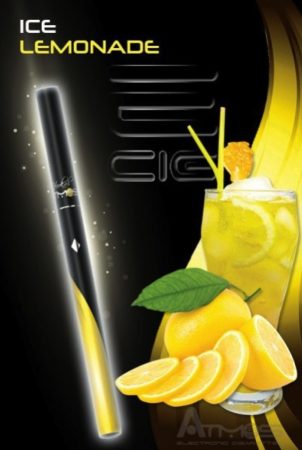Poisonings linked to e-cigarettes
Electronic cigarettes are increasingly a source of reports of harm made to poison-control centers, and young kids are often the victims

An e-cigarette is shown with a bottle of the flavored liquid that is injected in it to create tasty vapors.
©iStock.com/Snaprender
By Janet Raloff
E-cigarettes look much like traditional cigarettes, but don’t burn tobacco. Instead, they heat up a mix of chemicals to create a vapor that is breathed in. The practice is called vaping. That’s because users inhale gas vapors — not smoke — from these devices. Already millions of teens have tried vaping. And what they inhale can include nicotine, an addictive substance, as well as chemicals that cause cancer. Now, a report links poisonings to these tobacco alternatives. And the victims can be as young as kids in preschool.
E-cigarettes were developed as a way to help smokers stop using tobacco. In the United States, they have been available since 2007. But more and more people have been choosing to use these devices for another reason — for fun. And this includes teens. About one in every 10 U.S. high school students has used electronic cigarettes. Among middle school students, the number who have tried the devices is already one-third that high — and climbing.
Finding e-cigarettes is easy. Even local convenience stores sell them. And because the devices are not yet regulated by the government, in most cases, even pre-teens can legally buy and use them.
In fact, the e-cigarette industry has been targeting the sale of its products to teens , recent studies have found.But e-cigarettes are not completely safe. What’s more, even people who are not using the devices may be harmed by them, according to the new study.
Kevin Chatham-Stephens works at the Centers for Disease Control and Prevention, or CDC, in Atlanta. He and his co-workers surveyed logs of phone calls to U.S. poison control centers between September 2010 and February 2014. They looked for records of any calls that mentioned exposure to e-cigarettes or to the liquids that are burned in them to create those vapors. The scientists turned up 2,405 calls.
Almost 60 percent of e-cigarette calls reported harm from the products. Vomiting, nausea and eye irritation were the most common symptoms that physicians or other people talked about in the calls to poison control centers. Almost one in six calls about harm linked it to inhaling e-cigarette vapors. A similar number of calls described problems due to eye or skin exposures.
But more than half of the callers reported problems that occurred after eating or drinking the solutions — a mix of chemicals — that are bought to flavor e-cigarette vapors. That isn’t all that surprising because many of the vapor flavorings have been designed to appeal to our taste buds. This also may explain why half of the reports to poison control centers involved victims no more than 5 years old. Youngsters could have been drawn to the solutions’ smells or to the yummy foods pictured on their labels.

Right now, no one knows which chemicals might be responsible for making people who are exposed to e-cigarettes or their flavorings sick.
The CDC team found that calls to poison control centers about e-cigarettes have been rising sharply. Only one call was reported in September 2010. By February 2014, the rate had jumped to about 215 calls per month. Chatham-Stephens’ team reports its findings in the April 4 Morbidity & Mortality Weekly Report.
As half of the reported toxic exposures involves young children, the CDC researchers argue that finding a better way “to monitor and prevent future poisonings is critical.” Clearly, poisonings linked to e-cigarettes are “an emerging public health concern,” they write. That’s a message, the team says, that must reach the public, doctors, e-cigarette makers and the people who make and advertise flavored solutions for e-cigarettes.
Power Words
Centers for Disease Control and Prevention, or CDC An agency of the U.S. Department of Health and Human Services, CDC is charged with protecting public health and safety by working to control and prevent disease, injury and disabilities. It does this by investigating disease outbreaks, tracking exposures by Americans to infections and toxic chemicals, and regularly surveying diet and other habits among a representative cross-section of all Americans.
e-cigarette (short for electronic cigarette) Battery-powered devices that disperse nicotine and other chemicals as tiny airborne particles that users can inhale.
log The process of recording data for use or analysis later. For instance, doctors may ask people who take part in a drug trial to every day log how they feel and any change in their weight or health. Researchers can later go over the logs to see if and when people got better — or worse. Scientists tend to log all of the conditions of their experiments into lab notebooks. That way they can compare the findings from one test with all others — or what conditions they need to faithfully copy if they need to rerun a test.
tobacco A plant cultivated for its leaves. Dried tobacco leaves are burned in cigars, cigarettes, and pipes. Tobacco leaves are also sometimes chewed. The main constituent of tobacco leaves is nicotine.
toxic Poisonous or able to harm or kill cells, tissues or whole organisms.
vaping Slang term for the inhalation of vapors from e-cigarettes.
vapors Fumes released when a liquid transforms to a gas, usually as a result of heating.







